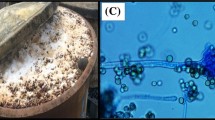Abstract
Purpose of work
To elucidate the mechanisms of high performance by soy peptides during yeast fermentation in low temperature stress conditions and to identify a type of soy peptide that is suitable for yeast fermentation at low temperatures during brewing.
The growth of a tryptophan auxotrophic yeast strain in a medium containing soy peptide (SP) was compared with that in a medium containing an equivalent composition of free amino acid mixture. At low temperature (10 °C), the cells grew in the medium containing SP but not in the medium containing the free amino acid mixture. Free tyrosine and phenylalanine inhibited the uptake of free tryptophan at low temperatures whereas most of the tyrosine and phenylalanine were present as oligopeptides in SP. The cells could transport free tryptophan without being inhibited by free tyrosine and phenylalanine at low temperatures in the medium containing SPs. Soy peptide-AM that lacks free tyrosine and phenylalanine was more effective in promoting cell growth compared with a highly hydrolyzed version.





Similar content being viewed by others
References
Abe F (2007) Exploration of the effects of High Hydrostatic pressure on Microbial growth, physiology and survival: perspectives from piezophysiology. Biosci Biotechnol Biochem 71:2347–2357
Abe F, Horikoshi K (2000) Tryptophan permease gene TAT2 confers high-pressure growth in Saccharomyces cerevisiae. Mol Cell Biol 20:8093–8102
Abe F, Iida H (2003) Pressure-induced differential regulation of the two tryptophan permeases Tat1 and Tat2 by ubiquitin ligase Rsp5 and its binding proteins, Bul1 and Bul2. Mol Cell Biol 23:7566–7584
Ayrapaa T (1965) The formation of phenethyl alcohol from 14C-labelled phenylalanine. J Inst Brew 71:341–347
Cai H, Kauffman S, Naider F, Becker JM (2006) Genomewide screen reveals a wide regulatory network for di/tripeptide utilization in Saccharomyces cerevisiae. Genetics 172:1459–1476
Homann OR, Cai H, Becker JM, Lindquit SL (2005) Harnessing natural diversity to probe metabolic pathways. Plos Genet 1:715–729
Horak J (1997) Yeast nutrient transporters. Biochim Biophys Acta 1331:41–79
Hori G, Wang MF, Chan YC, Komatsu T, Wong Y, Chen TH, Yamamoto K, Nagaoka S, Yamamoto S (2001) Soy protein hydrolyzate with bound phospholipids reduces serum cholesterol levels in hypercholesterolemic adult male volunteers. Biosci Biotechnol Biochem 65:72–78
Ito H, Murata K, Kimura A (1983) Transformation of intact yeast cells treated with alkali cations. J Bacteriol 153:163–168
Ito K, Hikida A, Kitagawa S, Misaka T, Abe K, Kawarasaki Y (2012) Soy peptides enhance heterologous membrane protein expression during the exponential growth phase of Saccharomyces cerevisiae. Biosci Biotechnol Biochem 76:628–631
Izawa S, Ikeda K, Takahashi N, Inoue Y (2007) Improvement of tolerance to freeze-thaw stress of baker’s yeast by cultivation with soy peptides. Appl Microbiol Biothechnol 75:533–537
Jones M, Pierce JS (1964) Absorption of amino acids from wort by yeasts. J Inst Brew 70:307–315
Kaino T, Tateiwa T, Mizukami-Murata S, Shima J, Takagi H (2008) Self-cloning baker’s yeasts that accumulate proline enhance freeze tolerance in doughs. Appl Environ Microbiol 74:5845–5849
Kitagawa S, Mukai N, Furukawa Y, Adachi K, Mizuno A, Iefuji H (2008) Effect of soy peptide on brewing beer. J Biosci Bioeng 105:360–366
Lekkas C, Stewart GG, Hill AE, Taidi B, Hodgson J (2007) Elucidation of the role of nitrogenous wort components in yeast fermentation. J Inst Brew 113:3–8
Maebuchi M, Samoto M, Kohno M, Ito R, Koikeda T, Hirotsuka M, Nakabou Y (2007) Improvement in the intestinal absorption of soy protein by enzymatic digestion to oligopeptide in healthy adult men. Food Sci Technol Res 13:45–53
Maebuchi M, Yamaguchi N, Huruya S (2011) Soy peptide as functional food component. Med Biol 155:566–576
Nagayama A, Kato C, Abe F (2004) The N- and C-terminal mutations in tryptophan permease Tat2 confer cell growth in Saccharomyces cerevisiae under high-pressure and low-temperature conditions. Extremophiles 8:143–149
Nishimura A, Kotani T, Sasano Y, Takagi H (2010) An antioxidative mechanism mediated by the yeast N-acetyltransferase Mpr1: oxidative stress-induced arginine synthesis and its physiological role. FEMS Yeast Res 10:687–698
Patterson CA, Ingledew WM (1999) Utilization of peptides by a lager brewing yeast. J Am Soc Brew Chem 57:1–8
Regenberg B, During-Olsen L, Kielland-Brandt MC, Holmberg S (1999) Substrate specificity and gene expression of the amino-acid permeases in Saccharomyces cerevisiae. Curr Genet 36:317–328
Schmidt A, Hall MN, Koller A (1994) Two FK506 resistance-conferring genes in Saccharomyces cerevisiae, TAT1 and TAT2, encode amino acid permeases mediating tyrosine and tryptophan uptake. Mol Cell Biol 14:6597–6606
Sikorski RS, Hieter P (1989) A system of shuttle vectors and yeast host strains designed for efficient manipulation of DNA in Saccaromyces cerevisiae. Genetics 122:19–27
Takahashi K (2005) The taste produced by the yeast of “Super Dry”. Seibutsu-Kogaku 83:532–533 (in Japanese)
Wiles AM, Cai H, Naider F, Becker JM (2006) Nutrient regulation of oligopeptide transport in Saccharomyces cerevisiae. Microbiology 152:3133–3145
Yokota H, Sahara H, Koshino S (1993) Fractionation and quantitation of oligopeptides in beer and wort. J Am Soc Brew Chem 51:54–57
Acknowledgments
We are sincerely grateful to Prof. Hideki Aoyagi at University of Tsukuba for discussion and enormous support. We thank Mr. Ryotaro Sato and Ms. Kanako Adachi for valuable discussions and technical assistances.
Author information
Authors and Affiliations
Corresponding author
Rights and permissions
About this article
Cite this article
Kitagawa, S., Sugiyama, M., Motoyama, T. et al. Soy peptides enhance yeast cell growth at low temperatures. Biotechnol Lett 35, 375–382 (2013). https://doi.org/10.1007/s10529-012-1088-z
Received:
Accepted:
Published:
Issue Date:
DOI: https://doi.org/10.1007/s10529-012-1088-z




